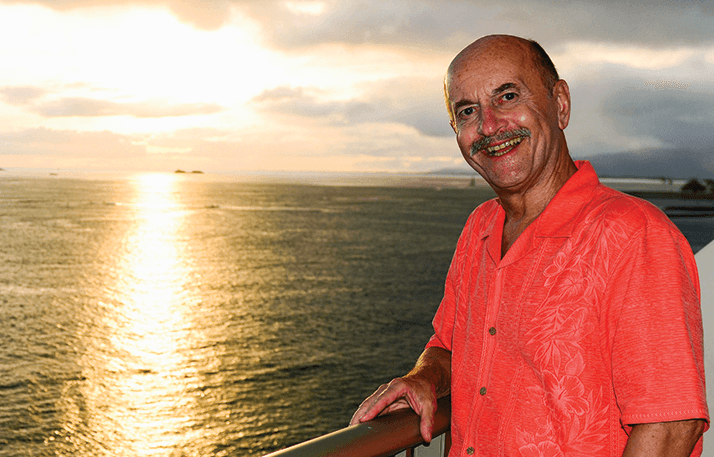
What gives you the greatest pleasure professionally? Working with students. Our research publications and patents are, to me, just a by-product; talented students are the real ‘product’. Of course, I get a kick out of coming up with new ideas, testing them and publishing the results. But seeing students’ eyes light up and watching them get involved in science is tremendously exciting. I had a pre-med student in my group a couple of years ago and the infectious enthusiasm for instrumental analysis corrupted him completely… He’s just finished his PhD with Graham Cooks at Purdue. Apologies to the medical community, but that’s very satisfying.
How do you instil enthusiasm? Perhaps the way I run my research group naturally selects those who are enthusiastic, motivated and independent. Graduate students need freedom – and perhaps one of the most important freedoms is the chance to make a few mistakes… that’s when we really learn. How did you dive into spectroscopy? Dive is perhaps not quite the right word. Going way back, I started out playing with chemistry as a kid, doing the kinds of things most parents disapprove of. I wound up pursuing synthetic organic chemistry at a tiny but well regarded placed called Hope College in Holland, Michigan. When I left, I was convinced to take a graduate course at the University of Illinois but the salary of a student wasn’t enough to support my family, so I took a position for a year in physical chemistry at the Illinois State Geological Survey. The following year, I entered Illinois graduate school as an inorganic chemist, where I met Howard Malmstadt, a great analytical chemist who had a major influence on my life and my career. That’s really when I got into spectroscopy. But it was somewhat by accident.
How so? Before graduate school, while at the Geological Survey, I heard a lecture by David Hercules, one of the patriarchs of analytical chemistry. He was focused on fluorescence at that time, and it led me to become interested in time-resolved fluorescence. And so when Howard Malmstadt talked to me about doing time-resolved spectroscopy I was excited; however, it turns out he meant spark spectroscopy and not fluorescence. Not that I was discouraged, but it required quite a shift in my thinking. You show the same kind of flexibility in collaborations... Yes. We’ve had a number of collaborative relationships that have been able to access small business innovative research and small business technology transfer research grants. The idea is to foster small business development through collaboration with universities. Several of our research products have been commercially developed. It’s very rewarding – and the students benefit from it too. Can you provide examples? We worked with LECO to develop an inductively-coupled plasma time-of-flight mass spectrometer (ICP-TOF-MS). We worked with Technicon to develop algorithms and instrumentation for near-infrared reflectance analysis. Our atomic absorption background correction system was commercialized. We’ve worked with several smaller companies to commercialize fiber optic sensors. There’s a device for ambient MS that we developed a few years ago, called the flowing atmospheric pressure afterglow (FAPA). Right now, we’re also working with a company in Australia on a new concept in TOF MS, called Zoom-TOF. And we’ve just patented something called distance-of-flight MS, for which we are seeking a partner.
You and others seem MS-focused right now. Is there a danger that optical spectroscopy is dying out? Heavens, no, not at all. Mass spectrometry has become prominent, and for good reason: it provides very high sensitivity and a lot of information. But let’s compare it with optical spectroscopy or nuclear magnetic resonance (NMR). As far as sensitivity goes, optical methods will usually win out over MS. That’s because even though MS has a low background, it’s ordinarily a destructive method; each ion is annihilated when it hits the detector. In contrast, if you have an isolated atom or molecule in solution, you can ‘look’ at it over and over again using optical spectroscopy. In fact, you can get about a million photons from each molecule before it photolyzes, so it’s relatively easy to do single molecule or atom detection with optical spectroscopy. And photons are clean! In contrast, it seems crude to inject samples directly into your mass spec instrument and get it all gummed up. NMR offers many different parameters to gain exquisite detail and thus fills up the information space much more fully. So, where is spectroscopy going? I'll make a bold statement: spectroscopy allows us to push the limits of space and time. We’re now using it to perform research on the attosecond (10-18 second) timescale and with sub-nanometer spatial resolution. Stand-off detection, for example, laser-induced breakdown spectroscopy, is an important trend right now. It’s been around for a while but is really catching on now – you spoke with Rick Russo (one of my former PhD students) and covered the Mars Curiosity Rover a couple of issues ago, right? A final bold statement: within the next few years, real-time imaging of individual molecules in motion will be possible; even now, researchers are approaching that goal.




